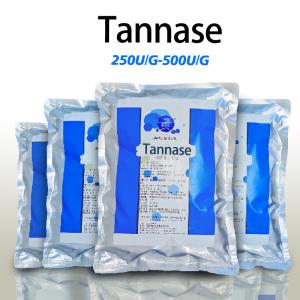
Add to Cart

| Product Details: Tannase is a tannyl hydrolase enzyme extracted by microbial fermentation, which has a hydrolytic effect on acids with two phenolic groups, such as tannic acid. The mechanism of action of tannase is mainly to cleave the ester bond between catechol and gallic acid, releasing gallic acid anions from tannic acid. In the food industry, tannins have a wide range of applications, such as processing tannins and proteins in beer to make them clear and transparent; Remove the astringency of foods such as persimmons; Manufacturing instant tea to prevent fermented tea from becoming cloudy. |

| Specifications: | |
| Origin | Nanning, Guangxi, China |
| Physical properties | Light yellow powder |
| Enzyme activity | 250U/G-500U/G |
| Odor | distinctive smell |
| Solubility | soluble in water |
| Fineness | 40 mesh, 60 mesh, 80 mesh (Customizable on demand) |
| Optimal pH value | 4.0-7.0 |
| Optimal temperature | 40-50℃ |
| Product execution standards | GB1886.174-2016 |
| Addition amount | 0.06-0.2% of tannin weight |
| Enzymatic hydrolysis time | 4-6 hours |
| Certification | HALAL certificate |
| ISO Quality System Certification | |
| FSSC22000 Food Safety System Certification | |
| Product specifications | Inner packaging: 1kg/bag, 5kg/bag, 20kg/bag. |
| Outer packaging: cardboard box, cardboard drum. | |

| Notices: 1. Enzyme preparations are bioactive substances that are susceptible to the inhibitory and destructive effects of heavy metal ions (Fe3+, Cu2+, Hg+, Pb+, etc.) and oxidants. Contact with them should be avoided during use and storage; 2. For people who are easily sensitive, it may cause hypersensitivity reactions; Close contact or slight inhalation may irritate the skin, eyes, and mucosal tissues; During the use of enzyme products, it is recommended to wear protective equipment such as masks and eye masks. 3. Moisture proof, light proof, sealed and stored at low temperature (0-10 ° C) for 18 months. Enzymes experience a certain loss of enzyme activity during storage, with 5-10% loss of enzyme activity at 10 ° C for 6 months and 10-15% loss of enzyme activity at room temperature for 6 months. 4. Extending the storage period or being affected by harsh storage conditions such as high temperature and humidity can lead to an increase in usage. |



